
views
X
Research source
It also gives you a chance to clean algal growths and shedding skin off an aquatic turtle.[2]
X
Research source
The procedure for bathing these animals is very similar, but a bit more caution is needed when bathing a tortoise. Be sure to wash your hands well after bathing your pet to avoid salmonella contamination.
Bathing an Aquatic Turtle
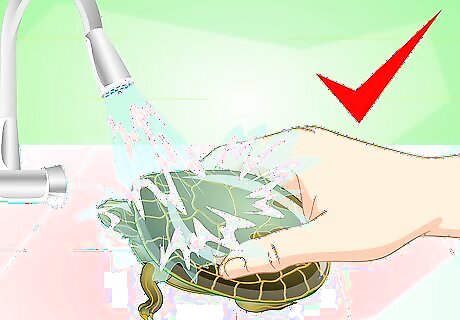
Bathe your turtle occasionally. Aquatic turtles spend the majority of their lives in the water and if their tanks are kept clean, rarely need a special bath. However, your turtle might benefit from a cleaning if it starts to develop algae on its shell, or when it is shedding to help remove dead skin cells. When your turtle is shedding skin, you may notice flaky patches of skin on its neck, tail or legs. This is normal. If your turtle sheds a lot, however, it might mean a problem with the tank or the turtle's health, and you should consult with your vet.

Obtain a dedicated turtle-washing tub. Turtles can harbor salmonella bacteria, which can make humans very ill, so it is important that you not bathe your turtle in the sink or bathtub. Salmonella is very resistant to disinfectants, so the best course of action is to buy or find a special tub for bathing your turtle, and use it only for that purpose. A plastic bucket or wash tub makes an ideal tortoise bath; just make sure it's large enough to accommodate your turtle.
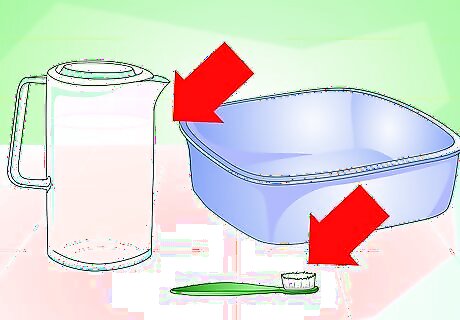
Assemble your other supplies. To bathe your turtle, you just need a tub, a toothbrush, and a jug or pitcher of lukewarm water, preferably de-chlorinated beforehand . You should not use any kind of soap or shampoo on your turtle, unless it was specifically recommended by your vet.

Fill the tub with water and gently place your turtle in the tub. The water should be room temperature water that has preferably been dechlorinated. Add at least enough water to reach the turtle's chin, more if you'd like to let it swim around a bit.

Scrub the turtle's shell. Use a toothbrush and gently scrub the turtle's entire shell, paying special attention to any areas of buildup. Remember that the turtle can feel his shell, so do not scrub too hard. Then scrub the turtle's legs, tail, and neck, but be careful with these areas as they are more sensitive. Finally, scrub the turtle's plastron (belly), and be sure to remove all algae and dirt between the scutes or scales. Do not use any kind of soap or polish on your turtle, this could injure it or make it ill!

Inspect your turtle as you scrub it. This is the perfect time to check your turtle all over for any sign of injury or disease. If you see anything out of the ordinary, take your turtle to the veterinarian to have it checked out right away. Common signs of turtle illness include swollen eyelids or ears, other swellings on the body, skin abnormalities, and discolored or fuzzy patches on the shell that may indicate shell rot.

Rinse your turtle and return it to its tank. Once your turtle is clean, you can rinse your newly shiny pet by pouring de-chlorinated water over it from a jug or pitcher before returning it to its enclosure.
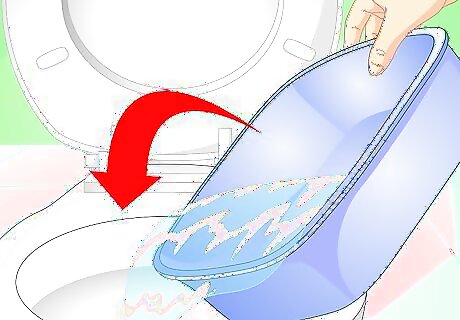
Dispose of bathwater carefully. To avoid the risk of salmonella contamination, you should not pour your turtle's bathwater down the sink. Flush it down the toilet, instead, and be sure to wash your hands thoroughly with soap and warm water when you are done.
Bathing a Tortoise or Semi-Aquatic Turtle
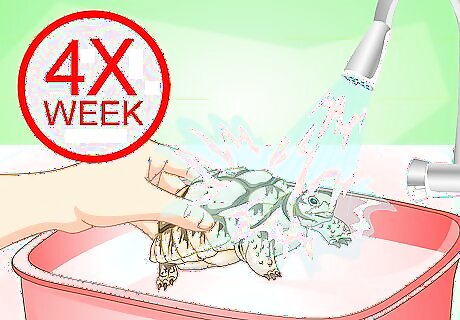
Bathe your tortoise often. Tortoises should be bathed at least 3-4 times per week. Some experts recommend bathing them every day when the weather is warm.
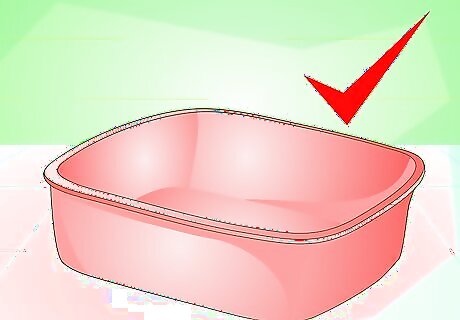
Obtain a dedicated tortoise-washing tub. Tortoises can harbor salmonella bacteria, which can make humans very ill, so it is important that you not bathe your turtle in the sink or bathtub. Salmonella is very resistant to disinfectants, so the best course of action is to buy or find a special tub for bathing your turtle, and use it only for that purpose. A plastic bucket, wash tub, or kitty litter pan makes an ideal tortoise bath; just make sure it's large enough to accommodate your tortoise.
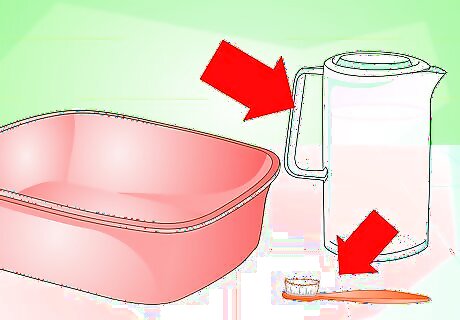
Assemble your other supplies. To bathe your tortoise, you just need a tub, a toothbrush, and a jug or pitcher of lukewarm water. You should not use any kind of soap or shampoo on your turtle, unless it was specifically recommended by your vet.
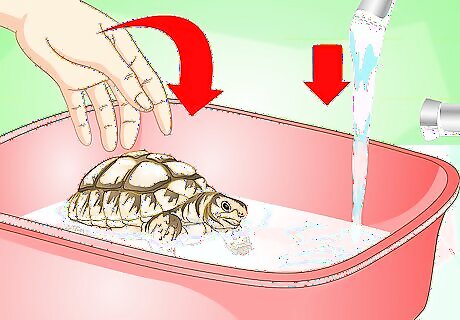
Place the tortoise in the tub and slowly add the water. The water should be room temperature. Add the water slowly until it is the depth of the tortoise's chin, or a bit shallower. Don't add more water than this, as most tortoises can't swim and could drown if their head is below water. It can also be helpful to rest the bowl on a book, so that your create a "deep" and a "shallow" end in the water. Place the chelonian with his head at the shallow end. This enables his anus to be below the water line, which is great because they drink through their anus so it's a great way of making sure he is well hydrated. Adding the water after the tortoise is in the tub ensures that you will not accidentally make the water too deep.

Let the tortoise soak. Just let your tortoise be in the water for 10 to 20 minutes. During this time the tortoise will drink water, and rehydrate further by absorbing water through its tail. It will also likely pass waste at this time. Usually it is sufficient to just let your tortoise soak and skip to the rinsing step, but once a week or so, you should give the tortoise a good scrub.

Pour out the soiled water, and refill the tub with clean water. Be sure to lift the tortoise out of the water while you pour the water out, to make sure it doesn't fall.

Scrub the tortoise's shell. Use a toothbrush and gently scrub the entire shell, paying special attention to any areas of buildup. Then scrub the tortoise's legs, tail, and neck, but be careful with these areas as they are more sensitive. Finally, scrub the turtle's plastron (belly), and be sure to remove all dirt between the scutes or scales.
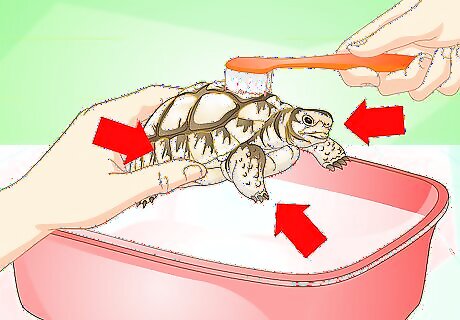
Inspect your tortoise as you scrub it. This is the perfect time to check your tortoise all over for any sign of injury or disease. If you see anything out of the ordinary, take your turtle to the veterinarian to have it checked out right away. Common signs of illness include swollen eyelids or ears, other swellings on the body, skin abnormalities, and discolored or fuzzy patches on the shell that may indicate shell rot.
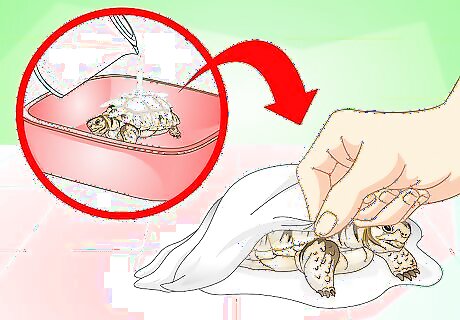
Rinse and dry the tortoise. Rinse your tortoise thoroughly using lukewarm water from your pitcher. Then place the tortoise on a towel, and wrap it up and over the tortoise to thoroughly blot the tortoise dry. You can then return your shiny, clean tortoise back to its enclosure.
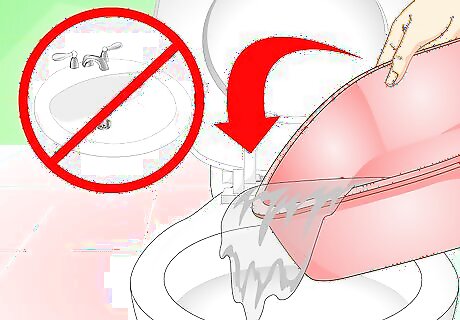
Dispose of soiled bathwater carefully. To avoid the risk of salmonella contamination, you should not pour soiled tortoise-water down the sink. Flush it down the toilet, instead, and be sure to wash your hands thoroughly with soap and warm water when you are done.

















Comments
0 comment